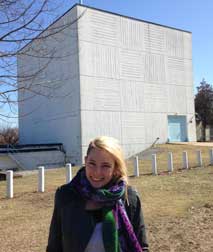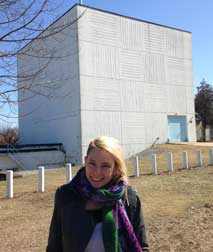 NARRAGANSETT, R.I. – April 7, 2014 – University of Rhode Island doctoral student Justine Sauvage is one of only five students in the country to be awarded a $30,000 fellowship this year to conduct research through the International Ocean Discovery Program. The prestigious Schlanger Ocean Drilling Fellowship will enable her to expand her studies of subseafloor sediments.
NARRAGANSETT, R.I. – April 7, 2014 – University of Rhode Island doctoral student Justine Sauvage is one of only five students in the country to be awarded a $30,000 fellowship this year to conduct research through the International Ocean Discovery Program. The prestigious Schlanger Ocean Drilling Fellowship will enable her to expand her studies of subseafloor sediments.
“I’m so excited that I got the fellowship; it’s sort of like the cherry on the top of my academic career,” said Sauvage, who is in the second year of her doctoral studies at the URI Graduate School of Oceanography. She earned a master’s degree at GSO in 2012.
A native of Brussels, Sauvage is studying the microbial activity deep in the sediment in the South Pacific gyre, the farthest place from land on Earth, a place where very few cells live and where even less organic matter ever reaches the seafloor. Sediments contain numerous radioactive elements, and it is likely that the living organisms are feeding on the hydrogen produced from the radioactive splitting of water, a process called radiolysis, since little else is available to eat.
“If that kind of nuclear life is taking place on Earth, then we can extrapolate that it may be happening in other less-hospitable environments characterized by wet sediments rich in radioactive elements, like subsurface Mars and Europa,” she said.
Sauvage is working to calculate how much hydrogen is being produced in the sediments in the South Pacific gyre in an effort to determine how much life can survive there. With her fellowship, she plans to expand this research to create a map of hydrogen production at different depths in the sediments around the world.
“Sediment characteristics differ from place to place because of different physical properties and different concentrations of radioactive elements,” she explained. “So hydrogen production will vary from place to place. At the end of my project I want to be able to look at the global scale to see the range of hydrogen production and where the hotspots are.”
Sauvage, who spent two months aboard a Japanese research ship in 2012 when it drilled deeper into the seafloor than any other ship in history, uses the nuclear reactor at the URI Narragansett Bay Campus to conduct experiments for her research. “It’s so convenient to have the reactor right here whenever I need a radiation source to irradiate my sediment samples. It’s nice to have the resources of the state at my disposal,” she said.
As she looks to her future, Sauvage is considering jobs in a variety of disciplines related to her current research, including nuclear science and alternative fuels.
“I really like what I’m studying now, but I want to apply it to something that’s a little bit closer to day-to-day life,” she said.
The International Ocean Discovery Program, which funds the Schlanger Fellowship, is an international marine research collaboration that explores Earth’s history and dynamics using ocean-going research platforms to recover data recorded in seafloor sediments and rocks and to monitor subseafloor environments.
Pictured above: Graduate student Justine Sauvage poses in front of the nuclear reactor at the URI Bay Campus where she does her research. (Photo courtesy of Justine Sauvage)

